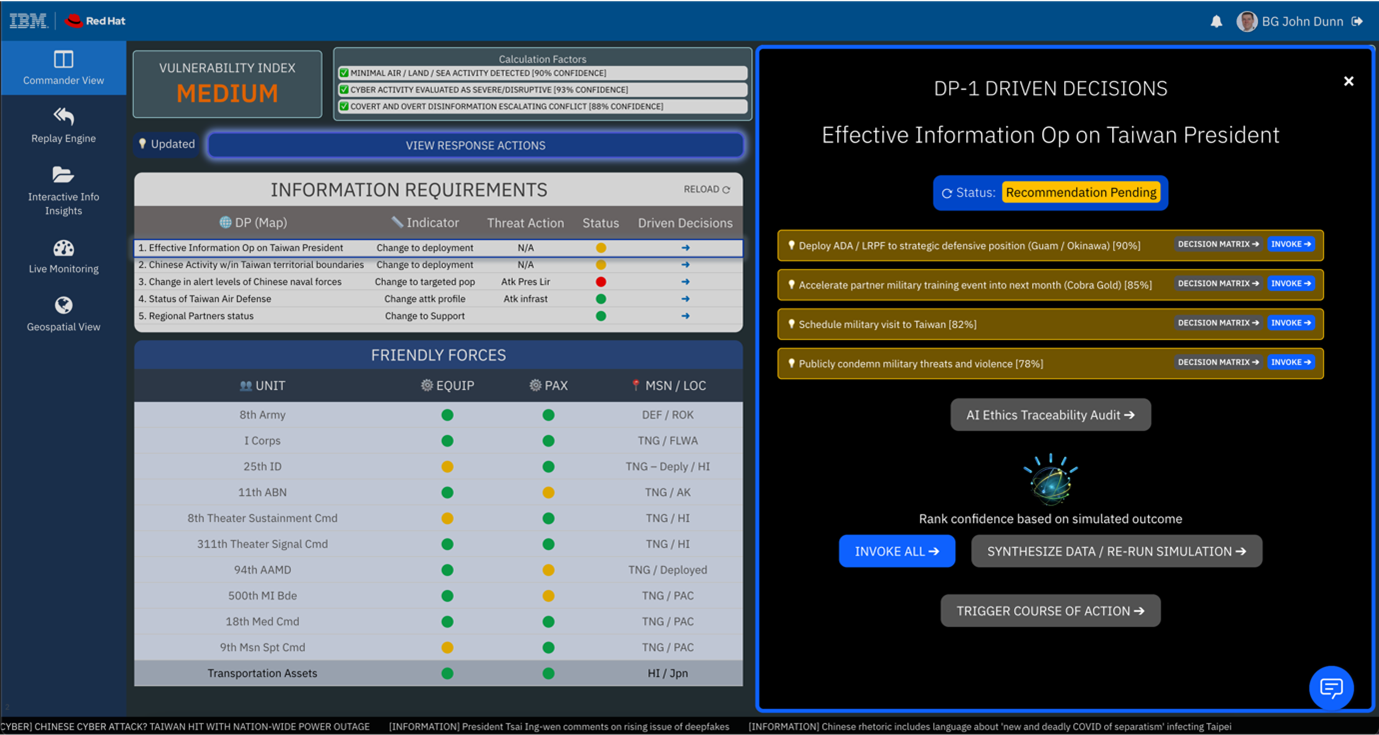Government
Embedding analytics and AI in mission command
11 November, 2022 | Written by: Chris Nott, Leendert van Bochoven, and Stephen Gordon
Categorized: Government
Share this post:
Defence chiefs are grappling with how to apply analytics and artificial intelligence (AI) for decision advantage knowing that commercial sectors already benefit. In particular, responding to activities designed by adversaries to coerce without military conflict and assist in decision making to act on specific operational problems.
A study by IBM’s Institute for Business Value last year highlighted an acceleration in adoption of AI in defence operations with information operations highest with 51% of departments piloting or implementing solutions. Our work shows that combining information operations across the five domains of air, land, maritime, space and cyber is necessary to sustain superiority over adversaries. However, it is the area where defence needs most help.
Last year, IBM and Red Hat introduced the Defense Simulation Analytical Service (DSaS) at the I/ITSEC conference in Orlando FL. We showed how mission planners, analysts and command staff can visualise what is taking shape in the information environment and use that analysis to expand the decision-making space.
Nevertheless, today’s mission commands process information in office tools and evaluate courses of action manually using table-top exercises. The few analytics tools that are deployed face difficulty accessing data, they are specialised and fragmented and therefore suboptimal for most tasks and nigh on impossible to integrate. Furthermore, few command and control (C2) systems have analytics embedded.
Digitising mission command
At this year’s I/ITSEC, IBM will be showing how we digitise mission command by providing a coherent array of data and tools that put analytics and AI at the heart of mission planning and operations. Analytics and AI are embedded, allowing the staff to focus on the commander’s priorities – to crunch data and provide insights that improve decision making.
DSaS has been enhanced with capabilities from defence ecosystem partners. Accessing such capabilities is in the hands of operators in the command centre through a marketplace. This helps optimise what data and tools are available at the edge. Capabilities that we shall show at I/ITSEC include:
- Operational decision support—Developed by Improbable. Applies real intelligence within a synthetic environment to reveal the outcomes of different approaches and reach the best course of action, faster. For example, helping battle the rise of disinformation in conflict areas by simulating how this disinformation spreads under different conditions.
- Interactive Maritime Mission Planning Tool—Developed by Matrix Games, Hadean, Lucky7 Digital and built on the Epic Unreal Engine. It simulates mission planning and execution to visualize and test courses of action for special operations deployment by exploiting real-time ocean observation data for hyper-precise volumetric representations of the maritime domain.
- The Weather Company provides hyper-realistic weather models, live weather conditions and visual rendering interface for high-realism virtual 3D environments. Powered by GRAF (IBM’s Global High-Resolution Atmospheric Forecasting system) that produces 12 trillion pieces of forecast information per day.
- Unreal Data: Improve Scenario Planning. Apply reinforcement learning to lever simulations & realistic yet synthetic behaviours to re-create any event and connect simulated events together to produce a broader, richer understanding.
IBM brings scale in two ways:
- Infrastructure: DSaS is built on Red Hat OpenShift allowing deployment from headquarters to the edge. This open source software standard is being adopted for containerised workloads by increasing numbers of defence departments around the world.
- Data: DSaS implements a data fabric that integrates data across the defence enterprise for the mission. It enables an agile, decentralized approach to offer data as a product.
Trusted data
The implementation of the data fabric employs a “factory approach” which manages and governs data pipelines and providing secure access to data through services. The factory implements IBM Cloud Pak for Data which uses AI and automation for secure and well-governed data fusion, cleansing and enrichment.

The same authoritative source for each specific type/piece of data is available to analytical dashboards and simulation tools to evaluate courses of action. It means that DSaS helps commanders assess how a situation is developing and what is available in response: the commander (via his/her staff) sees and understands what is going on and gets capabilities in place in advance of a situation deteriorating. In addition, the use of DSaS is interactive so that the system learns and improves through operator feedback.
Early adoption
Early examples of significant elements of this architecture have been deployed in both the US and the UK amongst others. Operational insight using AI exploited pre-defined and dynamic real-time data to support the decision making for Commanders and soldiers on the ground. It reduced the time spent planning operations by pre-analysing information and presenting this to the correct personnel to make faster and more informed decisions in an environment with limited communications.
Such success begins by working directly with users that will end up operating the system. The IBM Garage for Defense uses techniques with operators and technical specialist to co-create, conceive and build a minimum viable product (MVP). It means that the focus is on viability and delivering value to the mission quickly.
See for yourself
DSaS is evolving into a real-time mission planning environment for commanders and staff. During I/ITSEC, we shall show the workflow based on how information operations might alter behaviours, disrupt plans and set context for a contested Taiwan Strait escalation. This is a scenario developed by Dr. Frederick W. Kagan and Daniel Blumenthal of the American Enterprise Institute to help articulate the power of DSaS. It augments command staff for real-time situational awareness, risk assessment, evaluation of course of action and explainable recommendations with confidence levels.
Drop by the IBM booth #3165 at I/ITSEC 2022 to see DSaS. We can also arrange an in-depth presentation. Alternatively, we can set up a co-creation workshop to identify the priority for creating mission value and take the first step towards trusted decision making.

Global Technical Leader for Defence & Security

Global Lead for Defence and Intelligence Global Markets

Director Business Development, Defense & National Security, Red Hat
Unlocking Digital Transformation in Government
As the UK government embarks on its digital transformation journey, the challenges of adopting new technologies such as artificial intelligence (AI) and data-driven solutions are becoming more evident. From managing public trust to overcoming fragmented systems, the path is complex. Blake Bower and Giles Hartwright review the unique obstacles that the government faces and […]
